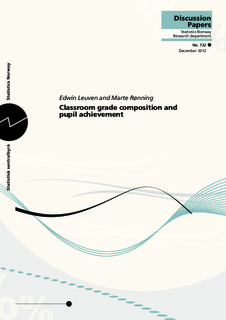Classroom grade composition and pupil achievement
| dc.contributor.author | Leuven, Edwin | |
| dc.contributor.author | Rønning, Marte | |
| dc.coverage.spatial | Norway | nb_NO |
| dc.date.accessioned | 2019-11-13T07:53:49Z | |
| dc.date.available | 2019-11-13T07:53:49Z | |
| dc.date.issued | 2012-12 | |
| dc.identifier.issn | 0809-733X | |
| dc.identifier.uri | http://hdl.handle.net/11250/2628025 | |
| dc.description.abstract | This paper exploits discontinuous grade mixing rules in Norwegian junior high schools to estimate how classroom grade composition affects pupil achievement. Pupils in mixed grade classrooms are found to outperform pupils in single grade classrooms. This finding is driven by pupils benefiting from sharing the classroom with more mature peers from higher grades. The presence of lower grade peers is detrimental for achievement. Pupils can therefore benefit from de-tracking by grade, but the effects depend crucially on how the classroom is balanced in terms of lower and higher grades. These results reconcile the contradictory findings in the literature. | nb_NO |
| dc.language.iso | eng | nb_NO |
| dc.publisher | Statistisk sentralbyrå | nb_NO |
| dc.relation.ispartofseries | Discussion papers;722 | |
| dc.subject | JEL classification: I2 | nb_NO |
| dc.title | Classroom grade composition and pupil achievement | nb_NO |
| dc.type | Working paper | nb_NO |
| dc.description.version | publishedVersion | nb_NO |
| dc.subject.nsi | VDP::Matematikk og Naturvitenskap: 400::Matematikk: 410::Statistikk: 412 | nb_NO |
| dc.source.pagenumber | 38 | nb_NO |
Tilhørende fil(er)
Denne innførselen finnes i følgende samling(er)
-
Discussion Papers [1002]
